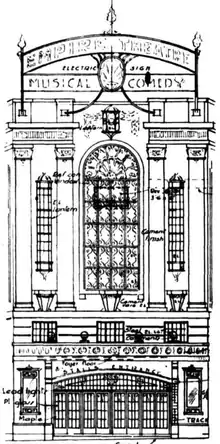Empire Theatre, Sydney
The Empire Theatre was a live music venue in Sydney for a few years before 1929 when it became a cinema. Around 1940 it had a dual role and by 1950 it was hosting various kinds of stage shows, increasingly musicals, and was finally destroyed by fire.
History
 |
| Railway Square, Haymarket 1 |

The theatre was designed by Kaberry and Chard,[1] and built by R. P. Blundell as a music hall for a syndicate led by leading bookmaker Rafe Naylor.[2] The site was a 150 by 130 feet (46 m × 40 m) block on the Bijou Lane corner of Quay Street ("Saunders' Corner"[lower-alpha 1]), Railway Square, near the side entrance to Central Station. It opened on 1 May 1927 with the new Jerome Kern musical Sunny, followed by The Student Prince.[3]
By this time stage musicals as public entertainment had been largely usurped by "talkies" and the theatre was reconfigured as a talking picture house around June 1929.[4] It was one of the few Sydney cinemas independent of the General Theatres Corporation / Fullers' Theatres combination, so showing few "first release" films, until management signed up with RKO, and with Paramount Pictures, who already had an arrangement with Prince Edward Theatre.[5]
During World War II, the Empire again hosted live performances, mounted by the A.I.F. Entertainment Unit[6][7] interspersed with regular movie programmes.
From 1950 the Empire was used by "The Firm" of J. C. Williamson's for minor attractions: "The Great Franquin" (a stage hypnotist),[8] a season of Gilbert and Sullivan favorites,[9] — and ballet performances, hosting a three-week season of the National Ballet Company of Melbourne, which included the world premiere of Corroboree, with its composer John Antill conducting the Sydney Symphony Orchestra.[10] Other ballet companies followed, culminating in the Borovansky Ballet in 1952.[11]
In 1953 "The Firm" announced a major refit and facelift for the old theatre, leading to calls (around the time of the Coronation of Elizabeth II) for it to be renamed "Her Majesty's Theatre".[12] The suggestion was taken up much later, when the musical My Fair Lady was being staged there.
The building was destroyed by fire in the early 1960s.
References
- "Advertising". Construction And Local Government Journal. XXXIV (954). New South Wales, Australia. 19 May 1926. p. 2. Retrieved 5 August 2020 – via National Library of Australia.
- "New Sydney Theatre". The Sun (Sydney) (4591). New South Wales, Australia. 22 July 1925. p. 10. Retrieved 7 August 2020 – via National Library of Australia.
- "Our New Theatre". The Evening News (Sydney) (18395). New South Wales, Australia. 7 June 1926. p. 11. Retrieved 5 August 2020 – via National Library of Australia.
- "The Australian Theatre and the Outlook". Sydney Mail. XXXV (908). New South Wales, Australia. 21 August 1929. p. 10. Retrieved 5 August 2020 – via National Library of Australia.
- "Film War". The Sydney Morning Herald (29, 688). New South Wales, Australia. 27 February 1933. p. 9. Retrieved 6 August 2020 – via National Library of Australia.
- "Concert In Aid Of A.I.F. Talkie Unit". The Daily Telegraph (Sydney). VI (71). New South Wales, Australia. 13 June 1941. p. 10. Retrieved 6 August 2020 – via National Library of Australia.
- "Servicemen, Families, Crowd Sunday Show". The Daily Telegraph (Sydney). VII (241). New South Wales, Australia. 28 December 1942. p. 5. Retrieved 6 August 2020 – via National Library of Australia.
- "The Greatest Entertainer Show Business has Ever Known". The Sun (Sydney) (12, 490). New South Wales, Australia. 7 February 1950. p. 18. Retrieved 7 August 2020 – via National Library of Australia.
- "Mikado Opens At Empire". The Sydney Morning Herald (35, 158). New South Wales, Australia. 26 August 1950. p. 10. Retrieved 7 August 2020 – via National Library of Australia.
- "Corroboree heads big ballet gala". The Sun (Sydney) (2448). New South Wales, Australia. 19 March 1950. p. 5. Retrieved 6 August 2020 – via National Library of Australia.
- "Tributes to ballet company". The Sun (Sydney) (13, 158). New South Wales, Australia. 1 April 1952. p. 14. Retrieved 6 August 2020 – via National Library of Australia.
- "Contact". The Sun (Sydney) (13, 517). New South Wales, Australia. 6 June 1953. p. 1. Retrieved 7 August 2020 – via National Library of Australia.
- So named for the long-established jewellery and gift shop nearby